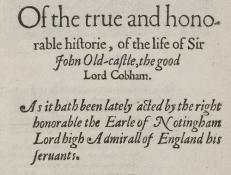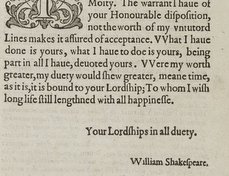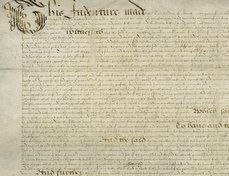Terms of use
Images that are under Folger copyright are licensed under a Creative Commons Attribution-ShareAlike 4.0 International License. This allows you to use our images without additional permission provided that you cite the Folger Shakespeare Library as the source and you license anything you create using the images under the same or equivalent license. For more information, including permissions beyond the scope of this license, see Permissions. The Folger waives permission fees for non-commercial publication by registered non-profits, including university presses, regardless of the license they use. For images copyrighted by an entity other than the Folger, please contact the copyright holder for permission information.
Copy-specific information
Title: The first part of the true & honorable history, of the life of Sir Iohn Old-castle, the good Lord Cobham. As it hath bene lately acted by the Right Honorable the Earle of Notingham Lord High Admirall of England, his seruants. Written by William Shakespeare.
Date: London : Printed for T.P., 1600 [i.e. 1619]
Repository: Folger Shakespeare Library, Washington, DC, USA
Call number and opening: STC 18796 copy 1, title page
View online bibliographic record
Peter Kirwan, "Sir John Oldcastle Part 1, second edition," Shakespeare Documented, https://doi.org/10.37078/160.
Folger Shakespeare Library, STC 18796 copy 1. See Shakespeare Documented, https://doi.org/10.37078/160.
The 1619 quarto of Sir John Oldcastle Part 1 is the first to attribute the play to Shakespeare, some three years after his death. The several plays published by Thomas Pavier in 1619, many with errors of date or authorship (probably deliberate) on their title pages, indicate Pavier’s interest in compiling a collection of “Shakespeare” plays around this time. The introduction of Shakespeare’s name onto an edition carrying the false date of 1600 had a significant impact on the Shakespeare canon for some time as, in 1664, Philip Chetwinde added to the second impression of the Third Folio all the plays published in Shakespeare’s lifetime with his name or initials on the title page (except The Troublesome Reign of King John (1611)). Therefore he also included Oldcastle.
The play remained in the Shakespeare canon through the Fourth Folio (1685) and the editions of Nicholas Rowe and the 1728 reprint of Alexander Pope’s edition (though Pope excluded it from his first edition in 1725). The play, along with the other 1664 additions excepting Pericles, formed the core of the several editions of disputed plays and Apocrypha in the nineteenth and twentieth centuries. However, its explicit ownership by the Admiral’s Men and the evidence from Henslowe that the play is by Munday, Drayton, Hathaway and Wilson means that there have been no serious scholarly attempts to attribute the play to Shakespeare or to anyone else. The play was one of only two of the 1664 additions excluded from Jonathan Bate and Eric Rasmussen’s 2013 edition of disputed plays as having no ongoing connection to Shakespeare. The play’s relationship to Shakespeare has been championed, however, by Peter Corbin and Douglas Sedge, whose The Oldcastle Controversy seeks to understand the plays associated with this historical figure in relation to one another.
Written by Peter Kirwan
Sources
Jonathan Bate and Eric Rasmussen, with Jan Sewell and Will Sharpe, eds. William Shakespeare and Others: Collaborative Plays (Basingstoke: Palgrave Macmillan, 2013).
Peter Corbin and Douglas Sedge, eds. The Oldcastle Controversy: Sir John Oldcastle Part 1, and the Famous Victories of Henry V (Manchester: Manchester University Press, 1991).
Last updated January 25, 2020












